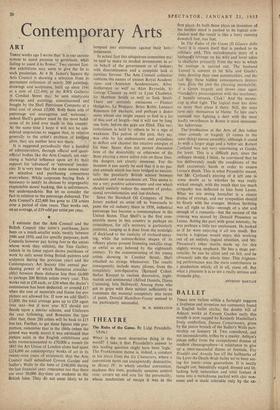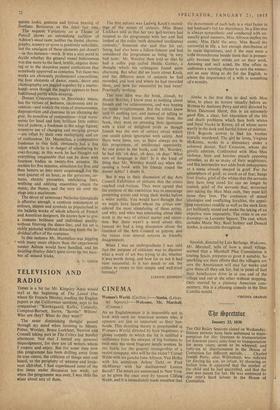BALLET
THREE new ballets within a fortnight suggests a liveliness and invention not commonly found in English ballet circles; the double bill of Ashton works at Covent Garden early this month is now capped by Kenneth Macmillan's lively confection, Dames Concertantes, given by the junior branch of the Sadler's Wells part- nership on January 18. Two considered, and not inconsiderable, trifles by a master, Ashton's pieces suffer from the occupational disease of modern choreographers—a reluctance to give up a once-successful theme or focmula. For Rinaldo and Armida has all the hallmarks of the Love-As-Death-Wish ballet we've been see- ing for years—even generations. It is neatly thought out, beautifully staged, dressed and lit; lacking both naturalism anci total fantasy it turns into a melodrama packed with chic non- sense and is made tolerable only by the ex-
quisite looks, gestures and lyrical bearing of Svetlana Beriosova as the fatal fair one.
The sequent Variations on a Theme of Purcell shows an astonishing collapse of Ashton's usual taste; neither the theme, choreo- graphy, scenery or score is positively unballetic, but the amalgam of these elements just doesn't —in this instance—work. It was a nice point to decide whether the general visual hideousness was due more to the hard, brittle, angular danc- ing or to the shapeless pastel confections that somebody approved as costumes. Yet these two works arc obviously professional concoctions; the four elements of dance, music; decor and choreography are juggled together by a master- hand—even though the juggler appears to have functioned partly while sleeping.
Danses Concertantes, to Stravinsky music, has the virtues of lushness, excitement and in- vention—and reveals the vices of strenuousness, disproportion and epatisme to an alarming de- gree. Its novelties of composition—trick move- ments for head and feet; brilliant little subtle- ties of pattern; a freshness in the adage figures; inventive use of changing and merging groups —are offset by their own multiplicity and air of restlessness. Mr. Macmillan, a comparative freshman in this field, obviously has a fine talent which he is in danger of smothering by over-forcing; in this work he has thought out everything imaginable that can be done with fourteen bodies in twenty-five minutes. He startles for five minutes, stimulates for five, and then batters us into mere acquiesence for the next quarter of an hour, as the gyrations, air- turns, electric pirouettes, undulating lines, writhing and eddying ensembles, churn the music, the theme, and the very air over the stage into a maelstrom.
The decor of newcomer Nicholas Georgiadis is effective enough, a cautious restatement of • colours, shapes and symbols as popularised in the balletic works of whole schools of French and American designers. He knows how to give a costume boldness and individual quality, without blurring the dance-line; and his set is richly pictorial without detracting from the in- dividual effect of the costumes.
A. V. COTON



































 Previous page
Previous page